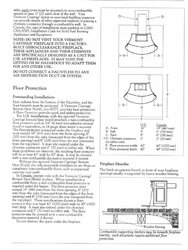My wife and I recently bought a house with a rarely used VT Castings Dauntless 1240 wood stove installed. The Dauntless 1240 is modeled on the old Franklin stoves. This stove has top exhaust and was installed new in 1992. Its more of a fireplace than a stove, but it is nice looking (red ceramic), it fits in the space well and it provides good ancillary heating to the great room it is located in when needed. Its not intended for, nor would I use it for long burns, but I'd still like to use it 6 to 8 hours at a time without worry.
My problem is that I'm certain the stove is not safely installed. I have the Owner's Manual and according to the manual the stove has safe clearances all around with the exception of the floor protection. The Stove has 3" legs and no heat shield for the bottom. It sits directly on standard 3/8" grouted ceramic floor tile. The floor tile is laid on 1/2" wood plywood sheets (that's right, no cement backer board) and the plywood is laid on wood floor joists.
In the Floor Protection section of the Dauntless owners manual it states " Without the optional Bottom Shield, the only acceptable installations are those on completely non-combustable floors, such as unpainted concrete over earth". That is pretty clear, but its not helpful. The stove and manual is old enough that there is no reference to R value insulation requirements.
If my only solution is a 6" fire brick and cement hearth pad I'll probably replace the stove. That would not be appropriate for the room. Also, the stove is on the first floor of a house with a full basement. I would be concerned about the weight that would be concentrated in one spot.
Is there any way I can calculate R value needs if I want to see about a hearth pad?
Any hearth pad R value suggestions?
I am open to all help and any suggestions you can provide. If I'm wrong and its safely installed that would be great, but I don't think that's the case.
Thanks In advance for your help
* edited for clarity.
My problem is that I'm certain the stove is not safely installed. I have the Owner's Manual and according to the manual the stove has safe clearances all around with the exception of the floor protection. The Stove has 3" legs and no heat shield for the bottom. It sits directly on standard 3/8" grouted ceramic floor tile. The floor tile is laid on 1/2" wood plywood sheets (that's right, no cement backer board) and the plywood is laid on wood floor joists.
In the Floor Protection section of the Dauntless owners manual it states " Without the optional Bottom Shield, the only acceptable installations are those on completely non-combustable floors, such as unpainted concrete over earth". That is pretty clear, but its not helpful. The stove and manual is old enough that there is no reference to R value insulation requirements.
If my only solution is a 6" fire brick and cement hearth pad I'll probably replace the stove. That would not be appropriate for the room. Also, the stove is on the first floor of a house with a full basement. I would be concerned about the weight that would be concentrated in one spot.
Is there any way I can calculate R value needs if I want to see about a hearth pad?
Any hearth pad R value suggestions?
I am open to all help and any suggestions you can provide. If I'm wrong and its safely installed that would be great, but I don't think that's the case.
Thanks In advance for your help
* edited for clarity.
Last edited:


